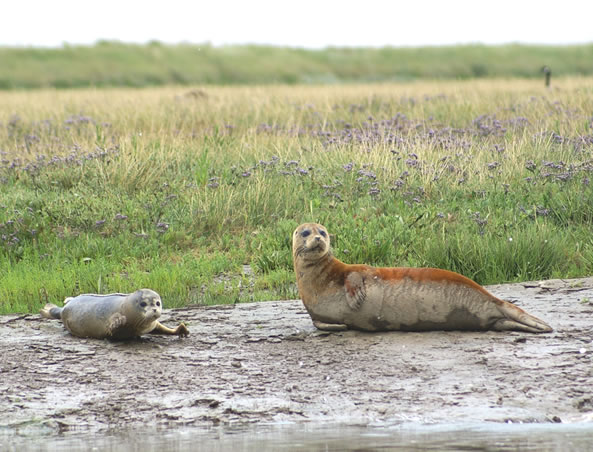Seals More Likely to Be Seen Near Hammersmith
New count finds that 138 harbour seals were born along the Thames in 2018

Harbour seal and pup - Graham Mee SE RSPB
The first ever comprehensive count of seal pups born in the Thames has provided clear evidence that harbour seals are breeding in London’s river. An incredible 138 pups were recorded by international conservation charity ZSL during the pioneering pup-count undertaken in 2018.
ZSL’s scientists tallied up the total of 138 pups after analysing hundreds of photos taken during the seal’s summer pupping season. The results of this analysis are being released by ZSL for the first time this month and form part of UK-wide seal monitoring initiatives.

Seal hitching a ride in August 2018
The team took photos from a light aircraft as the seals rested, undisturbed on the sandbanks and creeks below. It is much easier, and so more accurate, to count the seals in photos instead of the constantly moving, playful creatures. The Thames is home to both harbour seals and grey seals, though it is only the harbour seals that breed here.
Conservation Biologist, Thea Cox said: “We were thrilled to count 138 pups born in a single season. The seals would not be able to pup here at all without a reliable food source, so this demonstrates that the Thames ecosystem is thriving and shows just how far we have come since the river was declared biologically dead in the 1950s.”
Project Manager, Anna Cucknell, who leads ZSL’s Thames conservation explained: “The restored ‘Mother Thames’ - as we call her - is an essential nursery habitat and home to many animals including more than 100 species of fish, including two species of shark, short-snouted seahorses and the Critically Endangered European eel. Incredibly, harbour seal pups can swim within hours of birth which means they are well adapted to grow up in tidal estuaries, like the Thames. By the time the tide comes in they can swim away on it. Grey seals, on the other hand, take longer to be comfortable in the water, so breed elsewhere and come to the Thames later to feed.”
ZSL has conducted Thames seal population estimates annually since 2013. The most recent results, from 2017, recorded 1,104 harbour seals and 2,406 grey seals across the estuary. ZSL’s population surveys show that seal numbers in the Thames are rising but it is yet unknown if this is due to resident seals having pups or from adults migrating from other regions where colonies are known to be dwindling. For the first time in 2018, therefore, the team at ZSL undertook a breeding survey. The aim going forward is that the two survey methods will complement each other and allow ZSL’s researchers to better understand the seals in the Thames and the reasons behind their changing numbers.
Our local patch of the Thames appears to be a popular spot for seals. In July last year, a seal was spotted fishing by Putney Bridge and a month later, the seal in the picture above tried to hitch a ride on a single skull near the foreshore.
Wildlife experts warn that humans should enjoy seal sightings from a distance. Seals can become very stressed when approached, which uses up valuable energy resources. They also carry diseases which may be harmful to humans.
Though it has been on the rise, the seals are still vulnerable to a number of threats, such as plastic pollution. Seal hunting was made illegal in the 1970s, which led to a great recovery in their numbers. However, the Thames Estuary seals are threatened by construction projects such as one in Kent that planned to dredge up Goodwin Sands, a habitat for many seals.
If you spot a seal or another marine mammal you should report it to the
ZSL Thames Marine Mammal Survey.
September 13, 2019
Related links
|